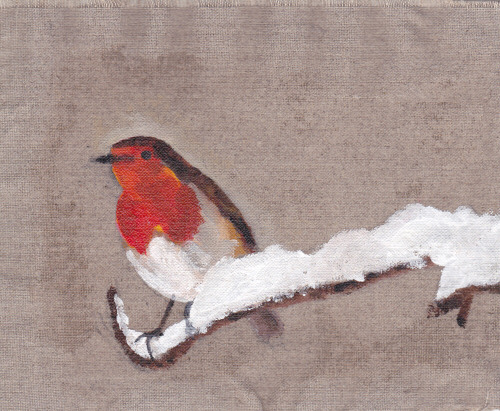
- by Tina Lewis
I never do any painting on linen so bought a few lengths of different linen grades to try out.
There’s such a huge variety of supports for artists to paint on, the two most common categories being a rigid surface such as a wooden panel or a canvas made from woven fibres. Of the canvas supports the choice tends to be between linen canvas and cotton canvas. Cotton being much cheaper is the one most artists use.
Linen is made from the fibre of the flax plant, the process of making the fabric is complex and labour intensive which accounts for its high price. It is also harder to stretch than a cotton canvas. Despite these negatives the resulting cloth is generally thought to be superior to cotton canvas for painting because:
a) it keeps its natural oils so the canvas doesn’t become brittle with time.
b) the warp and weft threads which make up the linen weigh the same so there is less expansion and contraction due to moisture.
b) it is very strong and durable and will last far longer than a cotton support.
Robin on Unprimed Fine Weave Linen
Unstretched Linen Canvas
The first I tried was some very fine unprimed linen, I painted on a little scrap of it. I wanted to keep the natural colour of the cloth on the unpainted areas so used clear gesso to prime.
It was pretty hard going as the canvas was neither stretched or pinned to a board (my fault!). The gesso was very rough and toothy which didn’t help matters either.
At this stage I wasn’t at all sold on the linen but kept an open mind until I had tried it stretched.
Lizard on Unprimed Fine Weave Linen
Stretched Linen Canvas
Another trial of the fine linen canvas, a lizard painting. This time I stapled the linen canvas to some cardboard and had a much more successful time of it.
Primed Fine Weave Linen
Unstretched Primed Canvas
These two very small cuts of universal primed fine weave linen were very nice to paint on. And yes, very fine and smooth (without getting slippery).
Painting on linen fabric that has already been primed is, of course, easier than having to prime the canvas yourself but you lose that natural colour – I’ve never seen any sold with clear gesso priming, only white.
Primed Medium Weave Linen
If you’re going to use cotton or linen canvas for painting you’ll also need to choose between the different grades of smoothness – fine weave, medium weave, coarse weave etc. The more details you aim to have in the painting the smoother you’ll want the canvas to be.
I also had a half metre of primed medium weave linen. Even though it isn’t as smooth as the fine weave I enjoyed painting this bowling shoe just as much as the blue forget-me-not flowers and ladybird. It’s cheaper than the fine weave so if a project demanded linen then this is probably what I’d get.
Frog Painting on Polyester Canvas
This final piece wasn’t on linen but it wasn’t on canvas either so I decided to include it here for interest.
In my search for a surface to replace the Winsor & Newton Winton Canvas Paper I used to love so much, I came across a seller of polyester canvas. The surface has the same regular pattern as the Winton but it was unprimed. I had to give it a few good coatings of gesso.
The result was a delightful surface to paint on, it wasn’t expensive and if not for having to gesso it I’d have ordered some more.
BTW that’s a red-eyed tree frog. I find frogs a lot of fun to draw and paint, maybe because it’s hard to make them look wrong. If you want to have a go but that looks like too much work then you could start by trying to draw a cartoon frog!





